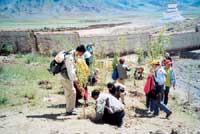|
|
||||
|
In Tibet, above all in Central Tibet, where water is very scarce and the altitude reaches over 4000 metres, trees are extremely rare and precious. Trees mean wood for cooking and for heating fuel, wood to build houses; they provide fruit, shade, protection from the wind, they also have roots that hold the soil firm on the occasions that it rains, at times very hard when, in summer, the Indian monsoon manages to cross the barrier of the Himalayas. Wood for building usually arrives here from far away regions, such as Amdo which can be found to the north-east of Tibet, and therefore has a price that the inhabitants of the villages simply cannot afford. To light the fire or to warm themselves during the freezing winter months, the inhabitants of Gangchen only have twigs or the dung of yak, which during the summer months are collected and placed to dry in the courtyards of the houses, but in reality these have a very low heating power. Fruit and vegetables are also rare, almost unknown in the villages; only in the city markets can you find fresh fruit and vegetables which arrive from China and are sold at high prices. Therefore, there is an extreme lack of vitamins in the diet and this, together with the problem of scarce and polluted water, creates a state of malnutrition which contributes to the spreading of various diseases, above all among the younger children. This year in Gangchen 250 trees were planted around the village and monastery. The aim is to transform the environment of Gangchen into an oasis, rich in plants, flowers, fruit and life. |
||||
|
|
||||



